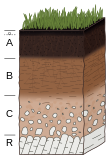The Unified Soil Classification System (USCS) is a soil classification system used in engineering and geology to describe the texture and grain size of a soil. The classification system can be applied to most unconsolidated materials, and is represented by a two-letter symbol. Each letter is described below (with the exception of Pt):
| First and/or second letters | Second letter | ||||||||||||||||||||||
|---|---|---|---|---|---|---|---|---|---|---|---|---|---|---|---|---|---|---|---|---|---|---|---|
|
|
If the soil has 5–12% by weight of fines passing a #200 sieve (5% < P#200 < 12%), both grain size distribution and plasticity have a significant effect on the engineering properties of the soil, and dual notation may be used for the group symbol. For example, GW-GM corresponds to "well-graded gravel with silt."
If the soil has more than 15% by weight retained on a #4 sieve (R#4 > 15%), there is a significant amount of gravel, and the suffix "with gravel" may be added to the group name, but the group symbol does not change. For example, SP-SM could refer to "poorly graded SAND with silt" or "poorly graded SAND with silt and gravel."
Symbol chart
| Major divisions | Group symbol | Group name | ||
|---|---|---|---|---|
| Coarse grained soils more than 50% retained on or above No.200 (0.075 mm) sieve |
gravel > 50% of coarse fraction retained on No.4 (4.75 mm) sieve |
clean gravel <5% smaller than No.200 Sieve | GW | well-graded gravel, fine to coarse gravel |
| GP | poorly graded gravel | |||
| gravel with >12% fines | GM | silty gravel | ||
| GC | clayey gravel | |||
| sand ≥ 50% of coarse fraction passes No.4 (4.75 mm) sieve |
clean sand | SW | well-graded sand, fine to coarse sand | |
| SP | poorly graded sand | |||
| sand with >12% fines | SM | silty sand | ||
| SC | clayey sand | |||
| Fine grained soils 50% or more passing the No.200 (0.075 mm) sieve |
silt and clay liquid limit < 50 |
inorganic | ML | silt |
| CL | lean clay | |||
| organic | OL | organic silt, organic clay | ||
| silt and clay liquid limit ≥ 50 |
inorganic | MH | elastic silt | |
| CH | fat clay | |||
| organic | OH | organic clay, organic silt | ||
| Highly organic soils | PT | peat | ||
ASTM D-2487
| Criteria for Assigning Group Symbols and Group Names Using Laboratory Tests | Soil Classification | ||||
|---|---|---|---|---|---|
| Group Symbol | Group Name | ||||
| COARSE-GRAINED SOILS More than 50% retained on No.200 Sieve |
Gravels More than 50% of coarse fraction on No. 4 Sieve |
Clean Gravels Less than 5% fines |
Cu ≥ 4 and 1 ≤ Cc ≤ 3 | GW | Well-graded gravel |
| Cu < 4 and/or Cc < 1 or Cc > 3 | GP | Poorly graded gravel | |||
| Gravels with Fines More than 12% fines |
Fines classify as ML or MH | GM | Silty Gravel | ||
| Fines classify as CL or CH | GC | Clayey gravel | |||
| Sands 50% or more of coarse fraction passes No.4 sieve |
Clean Sands Less than 5% fines |
Cu ≥ 6 and 1 ≤ Cc ≤ 3 | SW | Well-graded sand | |
| Cu < 6 and/or Cc < 1 or Cc > 3 | SP | Poorly graded sand | |||
| Sands with Fines More than 12% fines |
Fines classify as ML or MH | SM | Silty sand | ||
| Fines classify as CL or CH | SC | Clayey sand | |||
| FINE-GRAINED SOILS 50% or more passes the no. 200 Sieve |
Silts and Clays Liquid limit less than 50 |
Inorganic | PI > 7 and plots on or above "A" line | CL | Lean clay |
| PI < 4 and plots below "A" line | ML | Silt | |||
| Organic | Liquid limit—oven dried < 0.75 | OL | Organic clay | ||
| Liquid limit—not dried | OL | Organic silt | |||
| Silts and Clays Liquid limit 50 or more |
Inorganic | PI plots on or above "A" line | CH | Fat clay | |
| PI plots below "A" line | MH | Elastic silt | |||
| Organic | Liquid limit—oven dried < 0.75 | OH | Organic clay | ||
| Liquid limit - not dried | OH | Organic silt | |||
| HIGHLY ORGANIC SOILS | PT | Peat | |||
See also
- AASHTO Soil Classification System
- AASHTO
- ASTM International
- USDA Soil Taxonomy (Soil classification for agricultural purposes)
References
- Classification of Soils for Engineering Purposes: Annual Book of ASTM Standards, D 2487-83, vol. 04, American Society for Testing and Materials, 1985, pp. 395–408
- Evett, Jack and Cheng Liu (2007), Soils and Foundations (7 ed.), Prentice Hall, pp. 9–29, ISBN 978-0132221382
- Specific
- ^ Day, Robert W. (2013). Geotechnical engineer's portable handbook : with the 2012 international building code (2nd ed.). New York: McGraw-Hill. ISBN 978-0-07-178971-4. OCLC 837179787.
- ^ D 2487 – 06: Standard Practice for Classification of Soils for Engineering Purposes (Unified Soil Classification System) (PDF) (Technical report). ASTM International. 2006.
- ASTM Standard D2487, 2000, "Standard Practice for Classification of Soils for Engineering Purposes (Unified Soil Classification System)," ASTM International, West Conshohocken, PA, 2000, DOI: 10.1520/D2487-00, www.astm.org.
